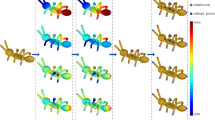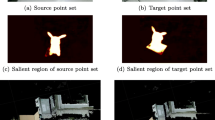Abstract
In this paper, a novel method is proposed to detect 3D object salient points robust to isometric variations and stable against scaling and noise. Salient points can be used as the representative points from object protrusion parts in order to improve the object matching and retrieval algorithms. The proposed algorithm is started by determining the first salient point of the model based on the average geodesic distance of several random points. Then, according to the previous salient point, a new point is added to this set of points in each iteration. By adding every salient point, decision function is updated. Hence, a condition is created for selecting the next point in which the iterative point is not extracted from the same protrusion part so that drawing out of a representative point from every protrusion part is guaranteed. This method is stable against model variations with isometric transformations, scaling, and noise with different levels of strength due to using a feature robust to isometric variations and considering the relation between the salient points. In addition, the number of points used in averaging process is decreased in this method, which leads to lower computational complexity in comparison with the other salient point detection algorithms.

















Similar content being viewed by others
References
Liu, J., & Wang, S. (2015). Salient region detection via simple local and global contrast representation. Neurocomputing, 147, 435–443.
Dutagaci, H., Cheung, C. P., & Godil, A. (2012). Evaluation of 3D interest point detection techniques via human-generated ground truth. The Visual Computer, 28, 901–917.
Pedrosa, G. V., Traina, A. J., & Barcelos, C. A. (2017). Retrieving 2D shapes by similarity based on bag of salience points. Multimedia Tools and Applications, 76, 20957–20971.
Pedrosa, G. V., & Barcelos, C. A. (2010). Anisotropic diffusion for effective shape corner point detection. Pattern Recognition Letters, 31, 1658–1664.
Jin, C., & Ke, S.-W. (2017). Content-based image retrieval based on shape similarity calculation. 3D Research, 8, 23.
Yang, Y., Hu, X., Wu, N., Wang, P., Xu, D., & Rong, S. (2017). A depth map generation algorithm based on saliency detection for 2D to 3D conversion. 3D Research, 8, 29.
Zhao, Y., Liu, Y., Wang, Y., Wei, B., Yang, J., Zhao, Y., et al. (2016). Region-based saliency estimation for 3D shape analysis and understanding. Neurocomputing, 197, 1–13.
Hajizadeh, M., & Ebrahimnezhad, H. (2016). Predictive compression of animated 3D models by optimized weighted blending of key-frames. Computer Animation and Virtual Worlds, 27, 556–576.
Agathos, A., Pratikakis, I., Perantonis, S., & Sapidis, N. S. (2010). Protrusion-oriented 3D mesh segmentation. The Visual Computer, 26, 63–81.
Atmosukarto, I., Wilamowska, K., Heike, C., & Shapiro, L. G. (2010). 3D object classification using salient point patterns with application to craniofacial research. Pattern Recognition, 43, 1502–1517.
Medimegh, N., Belaid, S., Atri, M, & Werghi, N. (2016). Statistical robust watermarking for 3D mesh models based on salient points. In Advanced Technologies for Signal and Image Processing (ATSIP), 2016 2nd International Conference on, pp. 52–56.
Mohamed, H. H., & Belaid, S. (2015). Algorithm boss (bag-of-salient local spectrums) for non-rigid and partial 3D object retrieval. Neurocomputing, 168, 790–798.
Liu, Y., Zhang, X., Li, Z., & Li, H. (2013). Extended cone-curvature based salient points detection and 3D model retrieval. Multimedia Tools and Applications, 64, 671–693.
Quan, L., & Tang, K. (2015). Polynomial local shape descriptor on interest points for 3D part-in-whole matching. Computer-Aided Design, 59, 119–139.
Bronstein, A. M., Bronstein, M. M., Bustos, B., Castellani, U., Crisani, M., Falcidieno, B., Guibas, L. J., Kokkinos, I., Murino, V, & Ovsjanikov, M. (2010). SHREC 2010: Robust feature detection and description benchmark.In Proceedings of 3DOR, vol. 2, p. 6.
Boyer, E., Bronstein, A. M., Bronstein, M. M., Bustos, B., Darom, T., Horaud, R., Hotz, I., Keller, Y., Keustermans, J, & Kovnatsky, A. (2011). SHREC 2011: Robust feature detection and description benchmark. arXiv preprint arXiv:1102.4258.
Ebrahimnezhad, H., & Ghassemian, H. (2008). Robust motion from space curves and 3D reconstruction from multiviews using perpendicular double stereo rigs. Image and Vision Computing, 26, 1397–1420.
Tombari, F., Salti, S., & Di Stefano, L. (2013). Performance evaluation of 3D keypoint detectors. International Journal of Computer Vision, 102, 198–220.
Reuter, M., Wolter, F.-E., & Peinecke, N. (2006). Laplace–Beltrami spectra as ‘Shape-DNA’of surfaces and solids. Computer-Aided Design, 38, 342–366.
Prakhya, S. M., Liu, B., Lin, W., Jakhetiya, V., & Guntuku, S. C. (2016). B-SHOT: A binary 3D feature descriptor for fast Keypoint matching on 3D point clouds. Autonomous Robots, pp. 1–20.
Chen, H., & Bhanu, B. (2007). 3D free-form object recognition in range images using local surface patches. Pattern Recognition Letters, 28, 1252–1262.
Zhong, Y. (2009) Intrinsic shape signatures: A shape descriptor for 3d object recognition. In: Computer Vision Workshops (ICCV Workshops), 2009 IEEE 12th International Conference on, pp. 689–696.
Mian, A., Bennamoun, M., & Owens, R. (2010). On the repeatability and quality of keypoints for local feature-based 3d object retrieval from cluttered scenes. International Journal of Computer Vision, 89, 348–361.
Agathos, A., Pratikakis, I., Perantonis, S., Sapidis, N., & Azariadis, P. (2007). 3D mesh segmentation methodologies for CAD applications. Computer-Aided Design and Applications, 4, 827–841.
Katz, S., Leifman, G., & Tal, A. (2005). Mesh segmentation using feature point and core extraction. The Visual Computer, 21, 649–658.
Lin, H.-Y. S., Liao, H.-Y. M., & Lin, J.-C. (2007). Visual salience-guided mesh decomposition. IEEE Transactions on Multimedia, 9, 46–57.
Mirloo, M. & Ebrahimnezhad, H. (2017) Non-rigid 3D object retrieval using directional graph representation of wave kernel signature. Multimedia Tools and Applications, pp. 1–25.
Del Alamo, C. J. L., Calla, L. A. R., & Pérez, L. J. F. (2015). Efficient approach for interest points detection in non-rigid shapes. In Computing Conference (CLEI), 2015 Latin American, pp. 1–8.
Walter, N., Aubreton, O., & Laligant, O. (2008) Salient point characterization for low resolution meshes. In Image Processing, 2008, ICIP 2008. 15th IEEE International Conference on, pp. 1512–1515.
Sipiran, I., & Bustos, B. (2011). Harris 3D: a robust extension of the Harris operator for interest point detection on 3D meshes. The Visual Computer, 27, 963–976.
Castellani, U., Cristani, M., Fantoni, S., & Murino, V. (2008) Sparse points matching by combining 3D mesh saliency with statistical descriptors. In Computer Graphics Forum, pp. 643–652.
Sun, J., Ovsjanikov, M., & Guibas, L. (2009) A concise and provably informative multi‐scale signature based on heat diffusion. In Computer graphics forum, pp. 1383–1392.
Chazal, F., Guibas, L. J., Oudot, S. Y., & Skraba, P. (2009). Analysis of scalar fields over point cloud data. In Proceedings of the twentieth Annual ACM-SIAM Symposium on Discrete Algorithms, pp. 1021–1030.
Peyré, G. (2011). The numerical tours of signal processing. Computing in Science & Engineering, 13, 94–97.
Surazhsky, V., Surazhsky, T., Kirsanov, D., Gortler, S. J., & Hoppe, H. (2005) Fast exact and approximate geodesics on meshes. In ACM Transactions on Graphics (TOG), pp. 553–560.
Pears, N., Liu, Y., & Bunting, P. (2012). 3D imaging, analysis and applications vol. 3: Springer.
Author information
Authors and Affiliations
Corresponding author
Rights and permissions
About this article
Cite this article
Mirloo, M., Ebrahimnezhad, H. Salient Point Detection in Protrusion Parts of 3D Object Robust to Isometric Variations. 3D Res 9, 2 (2018). https://doi.org/10.1007/s13319-018-0155-1
Received:
Revised:
Accepted:
Published:
DOI: https://doi.org/10.1007/s13319-018-0155-1




